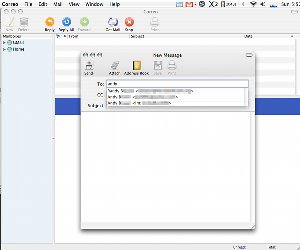Author: Nathan Willis
Just as Camino offers Mozilla Web browsing capability tightly integrated with OS X system services, its new sibling, Correo, aims to bridge the same gap for email. The open source email reader is based on Mozilla technology, but unlike Thunderbird it ties in to core Mac OS libraries in order to better the end user experience.
Correo 0.3 is the newest release, a 20MB .DMG file available for download from the project page. The application is a universal binary compatible with OS X versions 10.4 and up. Right now, two localizations are available: English and French. The project is a volunteer-run effort, not an officially sanctioned Mozilla app. Source code is available only for the 0.1 release, a situation lead developer Nick Kreeger says he will rectify once the app acheives greater stability. There is no installer; once you mount the downloaded disk image, just drag the Correo icon to your Applications folder, then double-click it to get started.
The grand tour
You can set up multple accounts, including POP and IMAP (with TLS and SSL security) for incoming mail, and multiple SMTP servers for outgoing mail. The interface is naturally similar to Thunderbird’s, although it sports fewer toolbar buttons, fewer columns in the message list, and fewer display options. It does feature a new icon set, simple and color coded.
Fewer display options does not mean a lack of flexibility, though — you can set up the mail view with three vertical columns or with the standard stacked, two-column view, and you can choose to open messages in the main window or in separate windows. The message list columns do betray some presently missing functionality, though, such as Thunderbird’s junk mail sorting and flexible threaded view.
The real selling point of Correo (as with Camino) is its integration with Mac OS X system services. With this release of Correo, that integration comes in two forms: Keychain access and Address Book connectivity. Keychain is OS X’s password and certificate management utility; with it you can authenticate to SSL servers in Correo (for IMAP access, for example) using a previously-saved account name and password. In theory, Keychain keeps the secrets for all the applications, so you do not have multiple apps each storing copies of your usernames and passwords. Using the OS X Address Book allows Correo to instantly fetch senders’ and recipients’ names and addresses, making it one less application requiring a separate contact info synchronization step.
Sizing it up
I had a little trouble getting Correo to authenticate against Gmail’s IMAP service — it complained of invalid credentials when I tried to fetch mail, even though I could verify with Thunderbird that the stored credentials were correct. And more troubling, whenever I opened the Account Manager to double-check the settings, it had forgotten my Gmail SMTP settings. Some of this may be due to Gmail’s peculiarities surrounding SSL authentication, though — I had no trouble setting up Correo to access a separate POP account that did not require SSL.
Correo, like Camino, has carved out a tight niche for itself. I know a lot of Apple enthusiasts, and they tend to be fiercely loyal to Apple’s built-in Mail app and Safari Web browser. On the other side, Mozilla fans can be dimissive of Camino as an underpowered “Firefox Lite” that — sans extensions — offers very little. With both Correo and Camino, it is the integration with the OS X system that makes the app valuable — not the app itself. And I confess, as much as I like Camino, I rarely use it — the OS X system integration just is not as important to me as the extensions I rely on so much in Firefox. In fact, I don’t think I care about Web browser / OS integration when I use Firefox on Linux or any other platform, either.
But that cannot be said of email and thus of Correo. Instant, transparent Address Book integration is a home run, and even without Keychain access, it would make Correo worth keeping. If you have ever tried to sync up your Thunderbird addressbook with OS X’s built-in Address Book app, you know what a pain it can be. When it comes to sychronization, one fewer location to worry about is always welcome.
Given Correo’s youth, I expect to see more functionality in future releases, perhaps rivaling the feature set of Thunderbird. For right now, if you can avoid the hiccups I encountered with Gmail IMAP, you may like the system integration enough that you give Correo a permanent place on your system Dock.
Categories:
- Reviews
- Mail & Messaging


